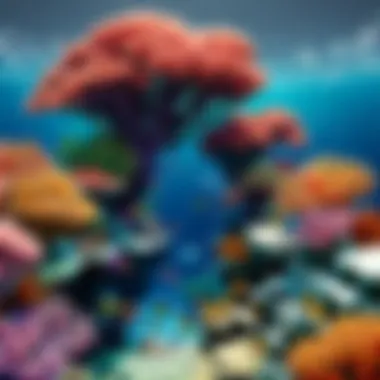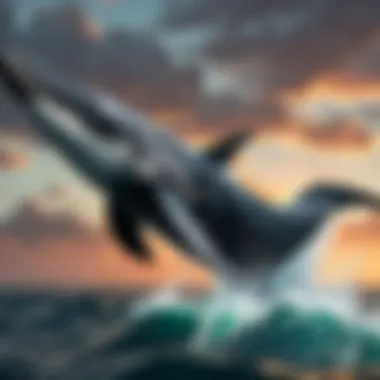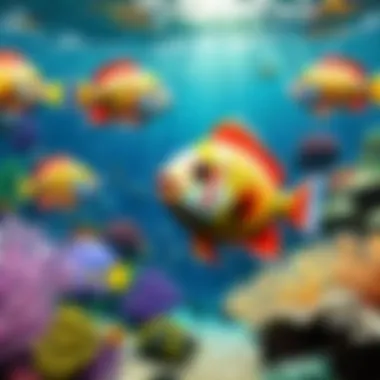Exploring Ocean Wildlife: A Deep Dive into Marine Life


Intro
Ocean wildlife represents a vast and complex ecosystem. The diversity of species found in the ocean is astonishing. From intricate coral reefs to the depths of the abyss, marine life plays critical roles in overall ecological balance. Understanding this life is essential.
But what challenges do these species face today? Increasing human activities, like pollution and overfishing, pose severe threats to ocean habitats. Conservation efforts increase in necessity as these issues grow. The initiative focuses on preserving ecosystems and restoring some species to their former numbers.
This article will guide readers through the various aspects of ocean wildlife. It examines species variety, ecological contributions, and significant risks caused by human actions. Additionally, we will explore effective conservation methods to protect this essential part of our planet.
Education about the ocean's richness affects our ocean attitudes. By increasing awareness, perhaps better actions will be taken for future generations. Understanding the depths of ocean ecosystems can inspire meaningful change and contribute to balance in our marine environment.
Intro to Ocean Wildlife
Ocean wildlife refers to all living organisms nestled within the extensive marine ecosystems. These ecosystems are complex, comprising diverse species including fish, marine mammals, invertebrates and coral reefs. Understanding ocean wildlife is foundational for grasping the intricate relationships and interdependencies among these species. Without grasping the diversity of ocean life, one cannot fully appreciate the essential balance maintained in these habitats.
Definition of Ocean Wildlife
Ocean wildlife encapsulates marine organisms that inhabit the oceans. This includes a range of species like sharks, turtles, whales, jellyfish, crabs, and the vibrant corals that form underwater structures. Each of these creatures plays a vital role, ensuring the ecosystem functions appropriately. The scope of ocean wildlife extends from microscopic plankton to the largest mammals on Earth, exemplifying the vast ecological tapestry within the ocean.
The Importance of Ocean Biodiversity
Biodiversity in ocean life serves several critical functions. First, it contributes to the resilience of ocean ecosystems. A healthy variety of species helps to buffer changes and withstand external pressures, such as climate change or pollution. Moreover, each species often fulfills a unique role within its habitat. For instance, species like the clownfish maintain the health of the anemones they inhabit, all while enhancing coral reef dynamics.
Biological diversity within oceans is not merely a luxury; it is a necessity for planetary health and functioning ecosystems.
Lastly, many ocean organisms are sources of food, critical to human sustenance and economies. From tuna fisheries to shrimp farms, supporting ecosystems that uphold sustainable harvesting is imperative. Thus, the preservation of ocean biodiversity amounts to safeguarding future resources for various organisms, including humans.
Major Types of Ocean Wildlife
Ocean wildlife encompasses a diverse range of species that play crucial roles in maintaining the health and balance of marine ecosystems. Understanding the major types of ocean wildlife is vital for grasping the intricate relationships that exist in these environments. Each group—such as fish, marine mammals, invertebrates, and coral reefs—contributes uniquely to ocean biodivesity and offers vital services to ecosystems. Recognizing their importance helps shed light on the current challenges they face and informs conservation strategies necessary for their protection.
Fish Species
Different Classifications of Fish
Fish are classified into three main groups: jawless fish, cartilaginous fish, and bony fish. Each group possesses unique anatomical features and habitats. For instance, jawless fish, including lampreys, have a simple structure without jaws, while the cartilaginous group consists of sharks and rays that have skeletons made of cartilage. Bony fish, which include most fish species, have a skeleton made of hard bone. This classification system is beneficial for the study of fish ecology, habitat preferences, and adoption in fisheries.
A unique feature is their adaptability to a wide range of aquatic environments, from the deep ocean to freshwater bodies. Understanding these different classifications enhances our knowledge of fish biology and ecological importance, directly impacting conservation efforts.
Role of Fish in Marine Ecosystems
Fish serve several vital functions in marine ecosystems. They participate in nutrient cycling, provide food for predators, and contribute to the health of habitats, such as coral reefs and seagrass beds. For example, herbivorous fish help maintain algae levels, preventing overgrowth that can choke coral.
A key characteristic of fish roles involves their place in food webs, where their presence supports the entire marine life cycle. Realizing how fish influence their surroundings is critical for ecosystem management and conservation practices, highlighting their many advantages.
Marine Mammals
Common Species of Marine Mammals
Marine mammals, including dolphins, whales, and seals, are significant components of the ocean's biological oceanography. These species often get attention due to their size, intelligence, and behavior, making them a popular subject in research and conservation narratives.
One distinguishing feature of marine mammals is their adaptability to living in water while still being air-breathers, which makes them unique compared to other ocean wildlife. Their diving abilities often dictate their feeding habits and play a role in maintaining species that reside in deeper, often less-explored, parts of the ocean.
Behavioral Patterns and Social Structures
Behavior among marine mammals varies extensively. Species like dolphins exhibit complex social structures, forming cohesive groups called pods. This social aspect not only showcases their intelligence but also creates a network of communication, cooperation, and even cultural learning. Understanding these groups helps illuminate how ecosystems function through social interactions.
Their social behaviors, however, are often threatened by human activities, making it imperative to study and understand them better for effective conservation efforts.
Invertebrates
Key Invertebrate Groups


Invertebrates make up a significant portion of ocean wildlife, with groups including cnidarians, mollusks, and echinoderms. The diversity among these groups is immense. For example, cnidarians include jellyfish and corals, and mollusks encompass octopuses and squids. Each group plays specific roles critical to the ecological balance.
One of the unique features of invertebrates is their ability to populate diverse habitats. They often serve as indicators of environmental change, highlighting their value in biodiversity assessments. Their varied roles in nutrients cycling and food web dynamics create a strong argument for invertebrates in conservation discussions.
Ecological Importance of Invertebrates
Invertebrates contribute significantly to marine ecosystems as producers and consumers. They aid in nutrient recycling through decomposition and habitat creation. A notable example is coral polyps forming coral reefs, which become habitats for numerous other species. Therefore, understanding the ecological roles of invertebrates is vital in the broader discourse on oceanic health and conservation strategies.
Coral Reefs
Structure of Coral Ecosystems
Coral reefs serve as some of Earth's most productive ecosystems. Their structure is built from calcium carbonate secreted by corals, making them essential for marine biodiversity. They act as habitats for a myriad of marine species, offering not only shelter but also feeding grounds.
The intricate structure of reefs speaks to the complex interactions between species. Healthy corals require clear, warm, and nutrient-balanced waters to thrive. Recognition of these environmental requirements is essential in protecting reefs against degradation caused by pollution and climate change.
Associated Marine Life
Coral reefs are home to approximately 25% of all marine species despite occupying a fraction of the ocean's surface. Fish, invertebrates, and marine mammals all depend on these systems for survival through food resources and nurturing habitats. The unique symbiosis in these ecosystems—highlighted by reef-building corals and their algae partners—creates an intricate system of life that is marvelous yet delicate.
Understanding coral ecosystems fosters insights into broader marine conservation efforts and highlights the necessity for sustained protection.
The Role of Ocean Wildlife in Ecosystems
Ocean wildlife plays a critical role in maintaining the health and stability of marine ecosystems. The complex interactions between various species form intricate webs of life that are essential for the survival of all ocean inhabitants, including humans. This section will explore both food chains and symbiotic relationships as central elements of ocean ecosystems.
Food Chains and Food Webs
Primary Producers
Primary producers, such as phytoplankton and seaweed, form the foundation of ocean food chains. They perform photosynthesis, capturing energy from sunlight to provide sustenance for a range of marine life. This aspect is fundamental in understanding the ocean's ecology, as they fulfill a vital role in energy transfer and nutrient cycling.
The key characteristic of primary producers is their ability to convert inorganic substances into organic matter. This characteristic makes them an essential focus for this article. While the diversity among primary producers is significant, silent champions like phytoplankton often do not receive enough attention despite contributing to the bulk of oceanic photosynthesis.
A unique feature of primary producers is their rapid growth rate, which can respond dramatically to favorable conditions. This presents both advantages and disadvantages: a flourishing population can simultaneously support an abundance of marine life while leaving ecosystems vulnerable to sudden disturbances.
Trophic Levels Explained
Trophic levels demonstrate the flow of energy through the ecosystem, illustrating the relationships among various species. This concept contributes to an understanding of the structure of marine ecosystems within the article. The trophic levels help readers grasp how energy transitions from primary producers to various consumers, including herbivores, carnivores, and top predators.
The key characteristic of trophic levels, involves the division of species into categories based on their feeding behavior. This aspect is beneficial for showing the interconnected nature of ocean wildlife. Moreover, details such as energy loss between levels are crucial in highlighting efficiency and biomass transfer.
One unique feature of trophic levels is their inefficiency; generally, only about ten percent of energy is transferred from one level to the next. This results in fewer high-level predators existing within an ecosystem, alerting to the fragility of certain animal populations dependent on specific base resources.
Symbiosis in Ocean Environments
Symbiosis describes the relationships between differing species and presents valuable insight into ocean wildlife dynamics. By examining mutualism, commensalism, and parasitism, this article will uncover their roles in ecological balance and species survival.
Mutualism Examples
Mutualism occurs when two species engage in a relationship benefiting both parties. This concept is significant in exploring cooperative interactions within ocean habitats. A well-known example includes the clownfish and sea anemones, where clownfish receive protection from predators, while anemones gain cleaning and nutrients from clownfish waste.
The key characteristic of mutualism is its reciprocal benefit. Including this section is vital, as it demonstrates the complex relationships that contribute positively to diverse ecosystems. Various mutualistic relationships highlight the intricacies that stabilize marine biodiversity and promote ecological resilience.
A unique feature of mutualism in ocean environments is its originality; this relationship is not merely survival, it relies heavily on trust and dependence among species. However, a disadvantage may arise since long-intact mutualistic associations can make species vulnerable, should their partner's populations experience decline.
Commensalism and Parasitism


Commensalism and parasitism can also provide insights into the dynamics of ocean ecosystems. Unlike mutualism, commensalism offers one party benefits, while the other remains unaffected. An example is barnacles that attach to whales, enjoying benefit without hindering their hosts. In contrast, parasitism involves one species benefiting at the expense of another, as seen in species such as parasitic sea lice that infest fish.
The key characteristic of these symbiotic relationships is their unique impacts on host and associated species. Including this segment benefits readers by broadening their understanding of ocean wildlife interactions that persist over time. It's important to consider how these varied relationships influence population dynamics and help support marine biodiversity.
However, both commensalism and parasitism reveal their own disadvantages, as hosts may suffer adverse effects, leading to lower resilience among certain populations. Understanding these relationships allows for a comprehensive approach to the overall functioning of marine ecosystems.
Understanding the roles played by ocean wildlife is vital for appreciating the delicacy and complexity of marine life and the ecosystems they inhabit.
Threats to Ocean Wildlife
Understanding the threats to ocean wildlife is crucial in this exploration of marine ecosystems. Human activity has dramatically altered ocean habitats. Overfishing, pollution, and climate change pose significant risks, undermining the health of marine life. Examining these threats reveals the urgency of protecting biodiversity. As we uncover individual elements of this topic, we gain insight into broader environmental issues.
Overfishing and Its Consequences
Overfishing brings about serious consequences not only to targeted fish populations but also to entire ecosystems. When species are harvested faster than they can reproduce, the balance in the marine food web is disrupted. This has wide-ranging effects, such as depletion of fish stocks and increased competition for remaining species. Topping this, the bycatch issue is critical too; non-target species that are caught unintentionally can suffer injury or death, further destabilizing ecosystems.
The decline in certain fish populations affects marine mammals and birds that rely on them for food. Species such as sharks and tuna are threatened, disrupting important roles these species play in maintaining ecosystem balance.
Pollution Effects on Marine Life
Pollution poses a significant hazard to marine habitats. Contaminants such as plastics, heavy metals, and chemicals can be detrimental to marine wildlife.
Types of Pollution
There are various types of pollution affecting oceans:
- Plastic Waste: From microplastics to large debris, plastics are pervasive in marine environments. They can entangle wildlife and are ingested by marine animals either intentionally or accidentally.
- Chemical Pollution: Chemicals from industrial runoff or agricultural fertilizers lead to harmful algal blooms. These can produce toxins that affect not just marine species but also humans.
- Ocean Noise Pollution: Man-made noises from ships and submarines interfere with the natural communication between marine species. Whales, for example, use sound to navigate and find prey.
Each type of pollution has characteristic challenges, making it pivotal to address comprehensively.
Long-term Impacts on Ecosystems
The long-term impacts of pollution extend beyond immediate effects. They result in persistent changes to ocean habitats. Coral bleaching, often caused by rising water temperatures and pollution, leads to the loss of entire coral reefs. This phenomenon has secondary consequences, leading to loss of biodiversity as countless species depend on these structures for shelter and sustenance.
A significant aspect of these impacts is the disruption of food chains. Persistent toxins can move up the food chain, harming larger predatory species. The consequences are felt across ecosystems, showcasing why addressing long-term impacts is essential.
Climate Change and Ocean Wildlife
Climate change heavily affects marine habitats and wildlife. The increasing global temperature leads to noticeable and threatening changes in oceans.
Temperature Changes
Rising sea temperatures are alarming. Many marine species are sensitive to temperature variations, affecting reproduction and migration patterns. Coral reefs, highly sensitive organisms, face severe bleaching when exposed to sustained heat.
This alteration leads to reduced fish populations, which depend on healthy reef systems for nurturing juveniles. It is a tough cycle; as fish populations diminish, recovery for temperate species becomes less likely, ultimately weakening the marine environment.
Acidification and Its Effects
Ocean acidification is another disorder linked to climate change. Excess carbon dioxide in the atmosphere dissolves into oceans, decreasing pH levels. Organisms like shellfish and coral face difficulties in forming shells or skeletons, leading to broader chances for ecosystem collapse. This issue ensures these keywords echo widely: sustainability, ecological integrity, and marine health.
In summary, the challenges faced by ocean wildlife are intertwined and complex. Understanding these threats forms the foundation for making meaningful progress in marine conservation.
Conservation Efforts for Ocean Wildlife
Conservation of ocean wildlife is crucial for maintaining the health of marine ecosystems. As human activities pose significant threats to ocean habitats and species diversity, targeted efforts to protect these environments have become essential. Proper conservation efforts not only preserve valuable marine life but also ensure that ecosystems remain balanced and functional.
Protected Marine Areas


Importance of Marine Reserves
Marine reserves serve a vital role in conservation strategies. These designated areas minimize human impact by restricting activities like fishing and tourism. The key characteristic of marine reserves: they create safe environments where fish and other marine species can thrive without external pressures. This protection leads to biodivesity recovery, allowing populations to rebound. Moreover, these areas often become breeding grounds, contributing to a sustainable fish population
The unique feature of marine reserves is their ability to foster ecosystem resilience. Reserves help maintain ecosystem functions that benefit surrounding areas, acting as a buffer against overfishing and habitat destruction. However, the establishment of marine reserves can face opposition, mainly from those affected by fishing restrictions, making community engagement a significant factor in their success.
Success Stories in Conservation
Highlighting examples of successful conservation projects strengthens the argument for further efforts. Key characteristics include community involvement, sustainable practices, and rigorous scientific research. These success stories, such as in the Bahamas and the Great Barrier Reef, demonstrate the power of collaboration among governments, non-profit organizations, and local stakeholders.
One unique feature of these initiatives is the methodology employed, where local knowledge is integrated with scientific tactics. This approach creates effective strategies tailored to specific ecosystems, which leads to palpable positive effects on wildlife minerals in those areas. Despite advantages in biodiversity recovery and increased local fishing yields, challenges remain, such as ensuring long-term commitment from all involved parties.
Legislation and Policy Frameworks
Effective legislation and policy shape the conservation landscape. Laws designed to protect marine life can significantly reduce detrimental activities and promote sustainable use of resources. A key characteristic of international agreements is that they implement globally recognized protocols for wildlife protection.
These agreements facilitate international cooperation, allowing for shared responsibilities and benefits among nations. However, the complexity of navigating global politics can hinder compliance, and enforcement often becomes a predicament. Much policy work is still needed to bolster adherence to these improvements.
Local Conservation Initiatives
Local conservation initiatives are fundamental to successful practices. These initiatives emphasize localized action based on specific community needs and ecosystems, thus promoting a hands-on approach. The key characteristic of local initiatives is community-led actions, raising awareness among residents regarding Whale migration patterns and environmental tools for education. These programs are beneficial because heavily-affected populations feel a sense of ownership toward marine conservation.
A unique feature is combining traditional methods with modern conservation strategies. By doing so, communities not only preserve their culture but also engage effectively in protecting habitats and species. Despite these strengths, one disadvantage is the potential for insufficient funding and broader policy support, highlighting the need for integrated resource approaches to ensure lasting impacts.
The emphasis on empowerment and localized efforts fosters a deep connection between community members and the health of marine environments.
Future of Ocean Wildlife
The future of ocean wildlife is absolutely vital for the health of our planet and human life. Future scenarios include challenges like changing climates, legislation, and advancements in scientific research. These elements combine and bring hope for better conservation strategies. With careful planning and actions, we can impact the world for future generations. The balance of marine ecosystems depends on our understanding here.
Innovations in Marine Research
Research is well-known to evolve, and innovations improve our grasp of the aquatic world. New technologies in marine biology help us monitor ecosystems more effectively. Remote sensing and underwater drones capture detailed data about ocean conditions, movements of marine species, and environmental changes. The advent of genomic research allows us to study genetic diversities within these habitats. Repairing ecosystems and rehabilitating polluted environments now has a stronger scientific basis. These methods can potentially match identification of new marine species or uncover hidden life forms in the vast depths faced.
New sectors, like synthetic biology, allow scientists to engineer marine organisms. Moreover, this research helps create microorganisms that may screen for pollutants in ocean water. Emerging studies on bioluminescent organisms play critical roles as potential indicators for ocean health. Understanding the life and its connections assist researchers in making more informed choices for conservation tactics moving forward.
Sustainable Practices in Fisheries
Sustainability in fisheries is essential for balancement in ocean wildlife. It is well understood that overfishing leads to declining fish stocks and causes significant ecological disturbances. Therefore, moving toward sustainable practices ensures that marine populations remain healthy for the long run.
Key practices include respecting fishing quotas, creating marine protected spaces, and using selective gear designed to reduce unwanted catches. Additionally, educating fishers about responsible fishing can play a crucial role. Their connection with oceans needs appreciation, weaving folks into conservation efforts by showcasing habitats. This way, sustainability aims not only for the protection of popular species but enriches entire ecosystems.
- Encourage local communities to partake in management decisions.
- Include indigenous knowledge that supports best practices.
- Develop certifications for sustainable seafood, guiding consumer choices.
Ultimately, responsible fishing can lead to a thriving marine environment. Future is within our grasp if broad understanding on these important issues can be cultivated.
Culmination
In understanding the complexities of ocean wildlife, it becomes clear that this subject encompasses a wide range of critical elements. The significance of marine ecosystems and the diverse species thriving within them cannot be overstated. Ocean wildlife is not only vital to maintaining ecological balance but also plays an integral role in supporting human life and economies.
Summary of Findings
Through our exploration, we have examined various aspects of ocean wildlife:
- The diverse range of species within fish, marine mammals, invertebrates, and coral ecosystems. Each group plays a unique role in maintaining the health of marine environments.
- The importance of biodiversity stresses that a loss in one species can have a ripple effect on the whole ecosystem. The interactions among species contribute to the stability and resilience of ocean habitats.
- We uncovered the significant threats that ocean wildlife faces, including overfishing, pollution, and climate change, all of which jeopardize marine life and the overall health of ocean environments.
- The proactive steps taken through conservation efforts illustrate that change is possible. Legislation and the establishment of protected marine areas serve to replenish and restore ocean ecosystems. The stories of success in various conservation initiatives inspire hope for the future.
Call to Action for Conservation
The health of ocean wildlife requires immediate and ongoing action. It is essential to:
- Raise Awareness: Reduce the knowledge gap about the issues that marine life faces. Education campaigns inform the public of how their behaviors impact the ocean.
- Support Sustainable Practices: Encouraging sustainable fishing practices can minimize the impact on fish populations and their ecosystems. Conscious choices in seafood consumption can help change industry practices towards more ethical approaches.
- Advocate for Policies: Participating in local and international efforts by supporting policies reinforces the significance of protecting marine environments. Effective policies rely on both government and community involvement to preserve oceanic biodiversity.
Conservation is an ongoing effort; true change demands rigorous commitment not just from governments but from individuals worldwide.
Together, through informed choices and collaborative actions, we can safeguard the precious resources of our oceans for generations to come.



